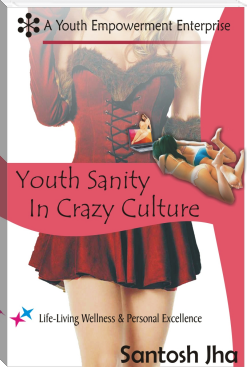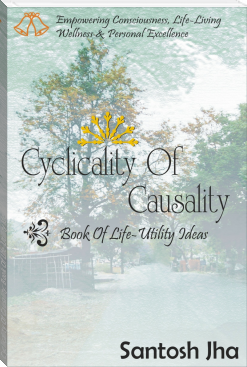Be Lonely, Be Your Best - Santosh Jha (the gingerbread man read aloud .TXT) 📗

- Author: Santosh Jha
Book online «Be Lonely, Be Your Best - Santosh Jha (the gingerbread man read aloud .TXT) 📗». Author Santosh Jha
Physical: Physical maintenance is essential for our cells and bodies. Adequate rest, sunlight, and exercise are examples of physical mechanisms for influencing homeostasis. Lack of sleep is related to a number of ailments such as irregular cardiac rhythms, fatigue, anxiety and headaches. It is the most common trouble of clutter culture. In a zeal to multitask, remain ever-connected and be in ever-happy mode, people are not only not sleeping enough hours but have also become victims of disturbed sleep. People generally believe that a walk in the evening or morning is sufficient. It is not. If you understand human evolution, you can easily understand how much physical labour is required for the maintenance of body balance. This natural body homeostasis was disturbed 10,000 years back when humans developed farming and started living a settled life. Consider what sort of life we lead. A good game of tennis, half an hour of swimming daily or some good running is the bare minimum we need. However, it also has to accept that rest and work go hand in hand. Either of the two is a recipe of disaster.
Genetic/Reproductive: Inheriting strengths and weaknesses can be part of our genetic makeup. Genes are sometimes turned off or on due to external factors which we can have some control over, but at other times little can be done to correct or improve genetic diseases.
Medical: Because of genetic differences some bodies need help in gaining or maintaining homeostasis. Through modern medicine our bodies can be given different props, but the potential for harmful effects is present. Most drugs have side effects and inappropriate drug administration is commonplace. Whether by infections, or wrong dosage of medication, homeostasis can be altered by that which is trying to fix it. Trial and error with medications can cause potential harmful reactions and possibly death, if not caught soon enough.
The factors listed above all have their effects at the cellular level, whether harmful or beneficial. It also has to be understood that the homeostasis imbalance in one system out of many body systems alone can cause other systems under stress as all systems are linked. We need to understand various body systems, which are related with each other for well-being. So, if our digestive system is in poor homeostasis, other systems like respiratory system or circulatory system also becomes stressed.
This however is not all about this very crucial realism of homeostasis. Homeostasis is not only about biological or physiological; it has wider manifestations. There are a growing number of economists, psychologists and other social scientists that have become interested in research on the determinants of wellness and happiness. It has been found after years of rigorous researches that individuals achieve a higher state of well being and happiness when they are in a homeostatic equilibrium, in larger sense of the term. This equilibrium state has physical, emotional, psychological, spiritual and environmental dimensions. Behaviour adjusts to restore the individual to homeostatic equilibrium through a combination of physical, emotional, behavioural and psychological adjustments. This behavioural readjustment is known as Allostasis.
It is now beyond doubt that when people are in a nurturing and free environment where there is trust, stability, good health, a satisfactory work environment, companionship with friends and family, people are generally happy and have a strong sense of well being. This represents the attainment of a homeostatic equilibrium at the environmental social, emotional and psychological levels.
However, overall homeostatic poise is not a permanent realism. Throughout their lives, people experience excitations to this equilibrium. Some of these excitations may be positive – a better job, promotion, birth of a child, marriage, movement to a better and more desirable living environment, greater security and trust, development of a more well integrated social life, exercise and more robust health, enjoyment of hobbies, friends and family, and so on. This would lead to a higher level of well being as the individual moves to a new homeostatic equilibrium. On the other hand, a downward displacement from a homeostatic equilibrium would lead to a lower level of well being.
Experts say, it is interesting that at a more fundamental level, the underlying model and motivations that drive behaviour in a model of homeostatic and allostatic adjustment are different from the maximizing calculus (instant-self-gratification) of microeconomic theory. Rather than decision being motivated by purely cognitive factors, the adjustment mechanism that drives behaviours in the case of homeostasis, involves a combination of cognitive as well as emotional imperatives.
This is interesting. Researches maintain that incomes do matter; comfort has a role in wellness but only till a stage. As wellness is a function of wider homeostasis, which includes factors, which are not only cognitive but also emotional, a person is in complete wellness when there is a balance between the cognitive factors such as income, wealth, comfort, leisure and health as well as emotional factors such as trust, security, integration with family-friends-colleagues, connectivity, stability, sense of desirability and spiritual purpose, etc.
Research confirmed that across geographies and ethnicity, people have shown the general tendency to move towards restoration of this homeostasis in case of a major shift away from it. This clearly suggests, like our biological system, homeostasis is our natural and desirable state of being, in all aspects of our life and living choices and there is a natural and instinctive urge to restore it. We are designed to act and behave in a way to return to set point of poise.
However, what is very important to understand and accept here is that even as most behaviour and actions of average people are aimed at attaining or restoring this crucial overall homeostasis, the actual choices depend mostly on how an individual subjectively perceives his or her life situation and what emotions shape or guide his or her choices. For example, a man, even in poor health, may opt for working more hours in office, instead of taking proper rest, if he perceives that he needs more money for better education of his kids. This leads us to this very important topic of how we all do risky behaviours, even when we are all wired to seek our overall homeostasis equilibrium.
We have explained earlier that you are in your perspective and your perspective is in you. This means, what and how an individual perceives his or her actual and real life situation can be very subjective. This hints at what we have earlier talked about loneliness. We are as lonely as we think we are. Similar is the realism with our perception about all things and life situations. This subjectivism of cognition is what we are talking about as we delve into this crucial subject as why people do loads of risky behaviour, which we see all around in contemporary clutter culture.
Scientists say, risky behaviour supports the hypothesis that a failure to adapt to losses or to attain an expected gain, to restore the homeostatic equilibrium induces risk seeking. Most kinds of risk seeking behaviours can be interpreted as a desire to return to an equilibrium level of wealth or any other parameter. This motivation is particularly strong when losses are involved. It is because sense of loss has more emotional impact than the sense of gain. This suggests, emotional inputs have larger subjective impact on perceptions and choices. Therefore, after a gain, many gamblers may take greater risks, guided by the emotion of larger gain. However, some gamblers may take a bigger risk, even when they lose, as they may be led by desperation to win at any cost.
Scientists say, this aspect of the relationship between risks and the homeostatic equilibrium relates to behavior that has been dubbed risk homeostasis. This behavior implies that there is an optimum or equilibrium level of risk that people are generally comfortable with. If this is true, then efforts to decrease risk may be met by riskier behavior. For example, when highways are designed to be safer, drivers increase their speed and take more risks and the accident rate remain at previous levels when highways were not safer. So, the finality of all behaviors depends on subjective sense of perception of realism.
Scientists say, this interpretation is crucial to understanding the variety of and huge amount of risky behaviors that we all see around us in our modern living environment. All around us, there are people, of all age groups, taking far too many risks that seem quite contrary to the belief that people in general have this intuitive inclination to move back to homeostatic balance. But, it has to be understood that any cognitive factor of wellness is also subject to emotional interpretation. Like; income and wealth as a key cognitive factor for wellness is important but only up to a limit after which it rather has negative impact. But, what actually is the optimum level of income and wealth is a subjective and emotional decision, given also the fact that we all live in a modern environment where income and wealth disparities are huge. Only 5 percent of global population owns 95 percent of wealth. This contemporary clutter culture has loads of such chaos, conflict and confusion, which irrationally affect choices of behaviors.
In such an environment, decision-making is more tilted towards emotional rather than logical. Scientists confirm that this cognitive-conundrum is biological, part of our body-mind mechanism, which we have already stated. Science says, confusion and chaos makes one emotional in thinking and value-summation as limbic system is activated. So, emotions make the fine-line between optimum and maximum blurred. This prompts risky behavior, even though, the behavior is towards restoring the homeostatic equilibrium.
In modern environment, there is a sense of relative safety and stability. This also prompts people to take more risks in creating wellness. Then, people have their own levels of emotional value-summation. A person may react very deeply and heavily if divorced and start taking risky behaviors, another may move on. So, individual reaction to homeostasis requirements and allostatic corrections may vary.
Understanding the dynamics of homeostasis and its functional mechanisms give us great insight as we can understand our own internal design of things and external environmental factors that have the potential to disturb our balance and poise of life. Balance in modern environment is something so rare but this is what we all need to have. That’s why, understanding this poise in all aspects of life and living can help. It should.
This entire lengthy discussion on homeostasis was aimed at knowing and accepting the two core facts, which we have been talking in this book since the start. First scientific fact is – the contemporary clutter culture is a dysfunctional and debilitating realism as it makes most of us land in chaos, conflict and confusion. This in turn lands us in a charged up emotional state affecting our logical and appropriate decision-making, as it blurs our perceptions about actualism of realism. This is what we talked about. The clutter culture affects our consciousness negatively and this in turn affects our cognition. Naturally, affected consciousness and illogical cognitions throws us in the deep oceans of bad and calamitous causality.
Second core fact emanates out of the first. That is; when the crucial 3Cs – Consciousness, Cognition and Causality are hit by another 3Cs – Chaos, Conflict and Confusion, we begin to lose the sense of appropriateness of self-awareness, self-control and self-actualization. That is why we begin to perceive some good and right things as bad and wrong and the vice-versa. This perception about the worth and utility of loneliness as some bad and wrong thing comes out of that situation, which most of us find ourselves deep into.
That is why, at the





Comments (0)